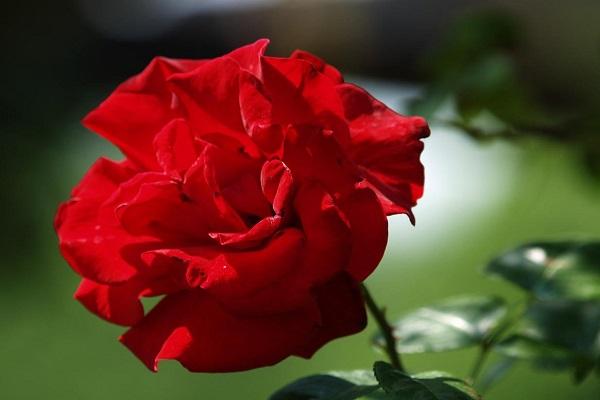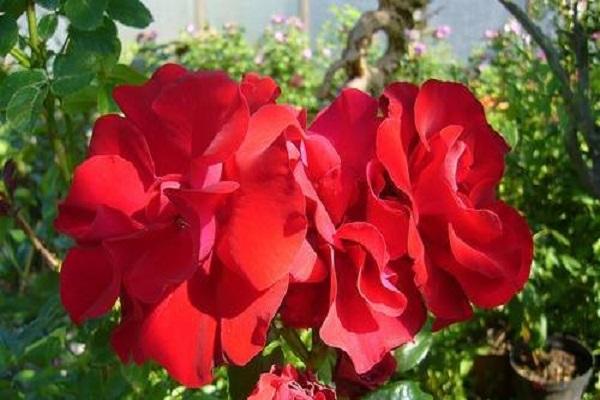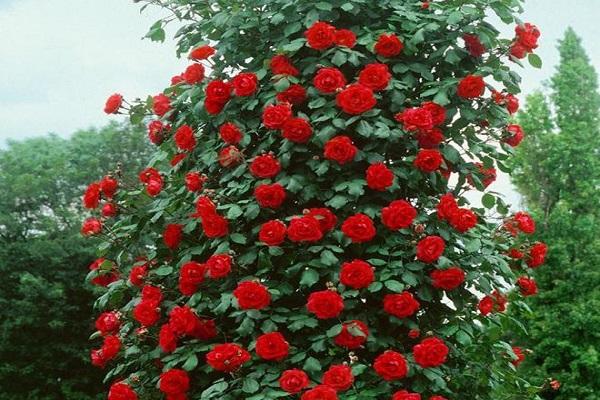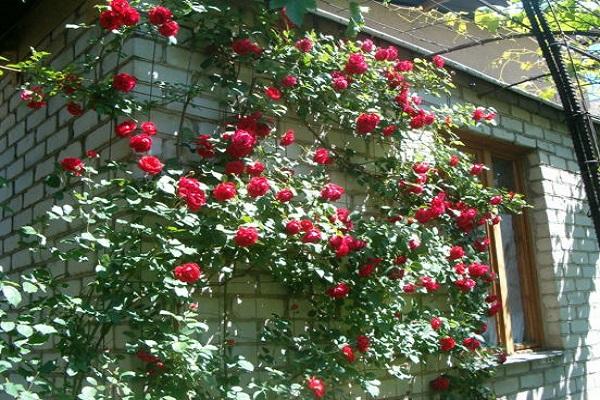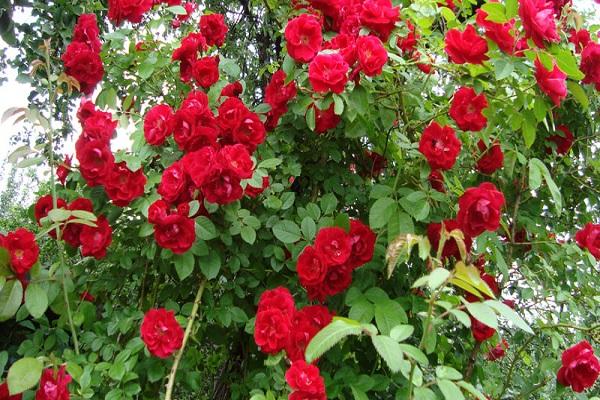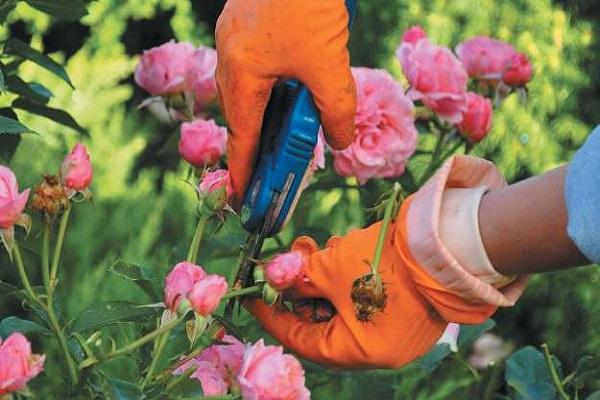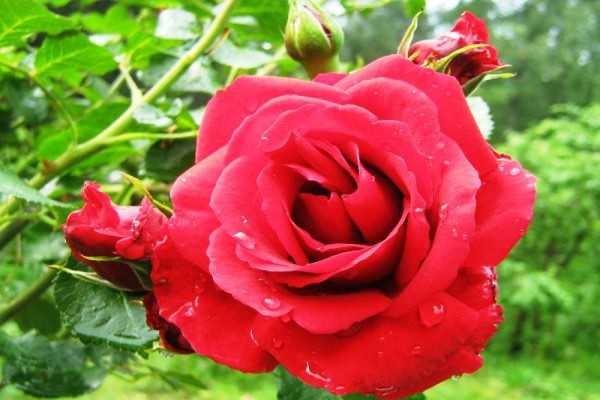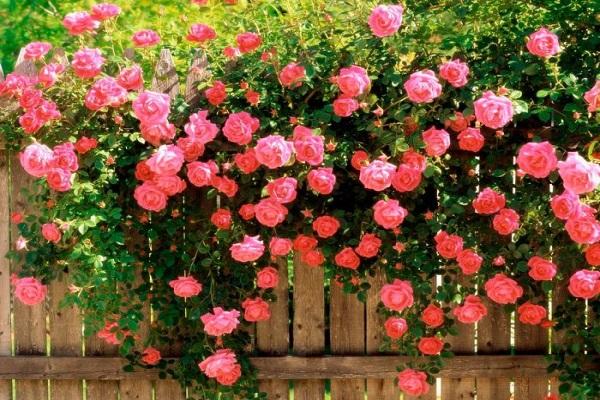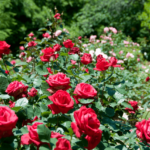The amazingly beautiful Santana rose will become the main decoration of a personal plot, garden or vegetable garden. The flowering of this type of rose begins in the first days of summer and ends in late autumn, which allows the bright large flowers to please the eye for a long time and create a good mood for others.
- General information about the flower
- Advantages and disadvantages of the variety
- When to plant a flower
- Selecting a location
- Preparation and planting of seedlings
- Care instructions
- Watering
- Loosening
- Mulching
- Feeding
- Preparing for winter
- Trimming
- Diseases and pests
- How to propagate
- Decorative properties
- Review of landing errors
General information about the flower
Santana is a type of climbing rose, so it easily fits into the landscape design of any garden.
Main characteristics of the plant:
- The height of the climbing rose bushes of the Santana variety reaches 3 meters, and the width is up to 2 meters.
- Velvety flowers have a rich dark red color.
- The branches of the flower are covered with clusters of inflorescences. One bunch consists of 3-7 buds.
- The scent of opened flowers is subtle and delicate.
- The opened buds have the shape of a bowl, and their diameter reaches 12 cm.
- The plant is frost-resistant, but it is preferable to grow the rose in warm regions.
- Loves a lot of sunlight.
- Tolerates heavy rains well. After the rains, it does not shed its petals, but becomes bright and rich in color.
- The inflorescences completely cover the branches.
- The variety is resistant to diseases and pests and, with proper care, blooms twice in one season.
With the help of the Santana rose, you can hide unattractive corners of the site and beautifully decorate any structure.
Advantages and disadvantages of the variety
The Santana rose, like any other plant, has its advantages and disadvantages.
Advantages:
- A large number of inflorescences.
- Resistance to frost and moisture.
- Cut flowers retain their appearance for a long time.
- Fast rooting in the ground.
- Constant lighting is not necessary for flowering; a rose of this variety will bloom in shaded areas
- Resistance to various fungal diseases.
Flaws:
- Small color range.
- Weak, barely noticeable aroma.
When to plant a flower
The right time for planting Santana is spring, from April to mid-May. If planting in the spring did not work out, then the bush should be planted from September to mid-October.
Selecting a location
To plant this type of rose, choose a well-lit area with constant air circulation, but without drafts.The southern or southwestern side of the garden or vegetable garden with a slight elevation is suitable.
Important! The seedling is planted taking into account its rapid growth and future climbing branches.
Preparation and planting of seedlings
When choosing seedlings for planting, you need to pay attention to the following characteristics:
- The plant should not have obvious damage.
- A seedling with a well-developed root system will take root faster and better.
- The young seedling should have several strong shoots.
- Before planting the plant in open ground, it is necessary to keep the seedlings in water, remove all excess leaves and be sure to treat the roots with an antiseptic. A solution of copper sulfate (3%) is suitable for this.
- Next, a hole is dug into which humus and water are added. The root system is buried no more than 30 cm. If planting occurs in the fall, then you can increase this size by 3-4 cm, and bury the trunk of the seedling with earth, about 20 cm up. This will enable the young plant to comfortably endure winter frosts.
- After planting, Santana is pruned. This action stimulates the growth and development of the seedling.
Care instructions
Climbing Santana is a picky plant, but it still requires some care.
If no mistakes were made during planting, then the bush will not cause unnecessary trouble or special care, and all difficulties of care are overcome in the first year of the plant’s life.
Watering
Santana does not require frequent watering, so a bucket of water once a week will be enough for the full development of this rose. Climatic conditions must be taken into account. If there has been a heavy downpour, watering should be postponed until the soil dries out. But if the weather is hot, dry, then watering is done carefully so that the scorching sun does not burn the leaves and flowers.
Loosening
The soil in which the rose is located must be loosened so that water and air can freely penetrate to the root system. That is why loosening the soil is called the dry irrigation method.
Mulching
In order for the plant to always feel good, you need to mulch or, in simpler terms, sprinkle peat compost mixed with sawdust into the soil around the plant. Such care will significantly improve the soil composition and reduce loosening and watering. Mulch is placed around the plant in the spring, when the rose is just waking up from hibernation, and the layer of such fertilizing can reach up to 10 cm.
Feeding
If in the first year of life the plant had enough fertilizer when planting it, then starting from the second year, additional feeding will be required. After spring pruning, mineral fertilizers, ammonium nitrate or urea will be useful.
After waiting 10 days, compost is added, which will provide additional nutrition to the rhizome. When the buds begin to form, the plant is fertilized with natural fertilizers in the form of chicken or cow droppings.
In September, rose Santana is fed with liquid organic fertilizers.
Preparing for winter
Important! Preparing the plant for wintering occurs only in dry weather.
To prepare Santana for the winter, you need to fulfill some care requirements:
- At the end of summer, stop loosening the soil under the bush.
- Remove the plant vines from the supports and trellises and inspect them carefully. Remove damaged leaves and branches.
- Collect dry leaves or spruce branches and carefully place the climbing bush on it.
- In case of severe frosts, insulate from above.
- If the winter is warm and mild, then excessive insulation is not necessary for the rose; it will go through the hardening stage and become stronger and healthier. Otherwise, the plant will rot from the excessive greenhouse effect.
Trimming
Climbing Santana requires proper haircuts and pruning. If this procedure is not carried out on time, the bush will develop a green crown to the detriment of flowering.
It is necessary to prune the rose during the winter preparation period, removing all old shoots and shortening young, rapidly developing lashes.
Due to the rapid and long flowering, by the end of the third year of life the main shoots of the plant weaken, so they need to be pruned, leaving the strongest and most flowering ones.
Spring pruning of roses involves removing vines that have rotted over the winter and creating a beautiful plant shape.
Diseases and pests
Rosa Santana is resistant to various diseases and pests. But even with its immunity, you need to strictly monitor the health of the plant.
The first signs of disease or pests:
- The roots are hidden from constant view and can be susceptible to various diseases. Therefore, if the plant has no external damage, but begins to fade, it is necessary to inspect the roots. If bumps are found on them, then most likely it is bacterial cancer. The cones are removed, and the root system is treated with an antiseptic. For roses there is such a remedy as copper sulfate.
- Black spots on rose leaves warn of disease. It is urgent to remove all infected leaves from the plant and add fertilizers containing potassium and phosphorus.
- Powdery mildew appears as a whitish coating on the foliage and stem of a plant and prevents it from developing and growing correctly and harmoniously.This scourge cannot be treated, therefore, in order not to infect other plants, the diseased rose must be removed from the area. To prevent powdery mildew, every spring it is advisable to spray all plants with a solution of copper sulfate.
How to propagate
The best way to propagate this beautiful plant is by cuttings.
To begin with, the upper branches of the bush are inspected and the strongest ones are selected. Then the cutting itself is cut off. The cut of the upper part of the shoot should be straight and located away from the bud, and the lower part, on the contrary, should be at an angle and close to the bud. The cutting is planted in a pot of sand and covered with a jar or film to create a greenhouse effect, and the soil is moistened.
You can also plant a climbing rose using seeds that have been previously prepared and have produced the first shoots.
But propagation by layering is carried out in the spring. To do this, the lower branches of the plant are sprinkled with soil and humus and watered abundantly. The next year, the cuttings are cut off from the plant and planted as an independent bush.
Decorative properties
The climbing rose Santana is an integral part of garden design. This plant is used to create garlands, arches, hedges and bright, beautiful gazebos.
With the help of this bush, unattractive buildings acquire a beautiful appearance, and old trees intertwined with such a rose will turn your garden plot into a fairy-tale world.
Review of landing errors
To enjoy the beautiful views of blooming roses throughout the summer and autumn, you must not make mistakes when planting them, which will lead to improper growth or death of the plant.
Here are the rules with which roses will grow healthy and strong:
- When planting, location is of particular importance.Roses love warmth and light, but do not tolerate strong winds.
- In damp and cold soil, Santana's roots will die.
- The soil should be neutral and light, with the addition of sand.
- Trees are bad neighbors for climbing roses; they take away moisture and vitamins necessary for life.
By following these simple rules, the climbing rose Santana will become the most beautiful plant in the garden or on a personal plot.

